In today's digital landscape, an effective SEO workflow is essential for driving organic traffic and ensuring your content is successful across the funnel.
In this guide, we will explore what SEO workflows are, the key players involved in creating and maintaining them, highlight the many benefits of using SEO workflows, and we will talk about the different kinds of SEO workflows you can use in your business.
Pro tip: Using an SEO workflow, or multiple SEO workflows, combined with following the five pillars of SEO, explained here, will give you incredible results!
Let's dive in.
What is an SEO workflow?
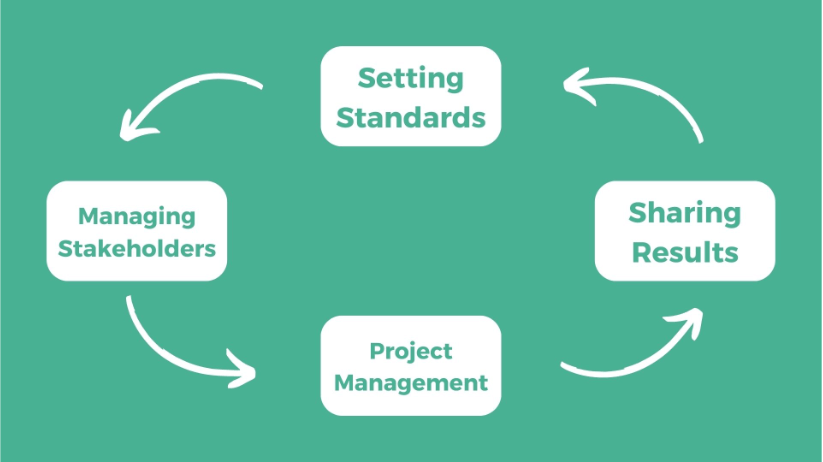
To put it simply, an SEO workflow is a set of steps that individuals and/or teams will follow to achieve a result when working on search engine optimisation campaigns.
This can be very over-reaching, listing out the steps for an entire SEO strategy, or you can have SEO workflows for different steps within the strategies, such as creating and publishing new content or running SEO tests.
You can configure your SEO workflows in different ways, some companies will have better results using a list format whereas others will find better results when using a flowchart. But, broken down to its core, an SEO workflow is a guide, listing the steps you need to take to get you to where you need to be.
Why do I need an SEO workflow?

The short answer is... You don't need an SEO workflow, but they are incredibly useful for businesses to have in place.
Ensuring you have a good SEO workflow in place is crucial to many business types as it allows them to become more efficient, keep processes in-place no matter who is working within a team and it allows them to train new starters up quickly, which is needed as a team grows.
The basic principles of SEO never change:
- You still need to be publishing great content.
- You still need to be building links from authoritative websites in your niche.
- You still need to demonstrate E-E-A-T.
- You still need a good technical SEO foundation.
Having the relevant SEO workflows in place for content, technical SEO, link building and the other important areas of SEO will help you keep focussed on the task at hand, ranking your website and earning more revenue.
Who is responsible for an organisation's SEO workflow?
Unfortunately, this is one scenario where I am going to have to give you the "typical SEO" answer to this question... It depends.
More specifically, it depends on the structure of your marketing team, how many people work within your organisation and the structure of your SEO strategies. However, we can make the argument for one person to be responsible for creating and maintaining SEO workflows within a business.
When we think of SEO strategies, we have the following tasks which are performed on a regular basis:
- Performing regular analysis of current campaigns and competitors.
- Planning and setting-out new campaigns.
- Tracking the results of past and present campaigns.
- Execution of different tactics within the overall campaign.
The person responsible for these tasks, at a management level, is generally going to be your SEO Manager or your Marketing Manager (if you do not have an SEO Manager within your organisation). This can be an in-house employee if you have this available, or it could be your agency account manager if you use an external agency.
We recommend that these individuals are responsible for the creation and maintenance of your SEO workflows. Yes, there will be individuals (such as content writers, link builders etc) who will be responsible for certain tasks within the SEO campaign itself, but your SEO Manager/Marketing Manager is going to be responsible for your whole campaign, and is therefore in the best position to manage your SEO workflows.
What are the benefits of using an SEO workflow?
There is a wide range of benefits to using SEO workflows within your work. We could spend all day listing out all of the benefits for business types, but to save you time, I will list out some of the main benefits.
Firstly, having defined workflows for all of your SEO activities, whether it's creating new content, updating existing content, link building outreach or anything else, is going to be of great benefit to existing staff and new starters. You are creating a repeatable process that can be used, no matter whether the person who creates it in the first place leaves the business. We know that it's very rare for someone to stay at a business for their entire career, so we need to ensure that the work can carry on as normal if someone does leave the business.
We can also use our SEO workflows to analyse processes from a "bird's eye view" which will allow us to identify and eliminate steps that are no longer needed within our processes. For example, if you are using a content creation SEO workflow, you may be able to identify an editing process that no longer needs to be included (for example, if someone new joins the business) and you can eliminate this process entirely.
You will free up your management team. They will spend less time working on individual jobs within the workflow itself and more time working on those higher-priority tasks allowing the business to move further forward in less time. This is especially helpful for small businesses with limited resources.
What are the different types of SEO workflows?
As we've touched on a little bit within this article already, there are different types of SEO workflows for different businesses to utilise depending on their size and sector.
Given most businesses will utilise content in their SEO strategies in some way, shape or form, we have decided to focus on the different content SEO workflows.
New Content Workflows
Regularly publishing content is one of the pillars of a quality SEO strategy. It allows you to get more clicks to your website, reach more potential customers, better demonstrate EEAT to Google and build your brand authority.
Because of all this, having an SEO workflow for new content is crucial. In terms of what your workflow will look like, it will be different for each business. But it could look something like this:
- Content research is conducted and a brief is written.
- The content brief is approved.
- The first draft of the article is written.
- The first draft gets sent off for review.
- A second draft is written based on the review.
- The second draft is reviewed (and hopefully approved.)
- The content is published.
Within the above, every team member is going to know their jobs, and you can combine this with a project management tool like Asana, Notion or Monday to ensure everyone knows when their jobs are coming up.
Content Optimisation Workflows
Optimising or updating content is slightly different. In this case, you spend less time on research (as the bulk of the research has been done, you are now filling gaps in search intent and content gaps) and you spend more time on optimisation and distribution.
In this example, an SEO workflow for content optimisation may look something like this:
- Find low-quality content.
- You can use the SEOTesting Content Decay Report to find this.
- Identify content or questions missing from your piece.
- You can use tools from SEOTesting such as the Striking Distance Keywords Report or the Questions to Answer Report to help with this.
- Conduct a content gap analysis to identity other missing content from competitors.
- Re-write the content, add missing information.
- Publish the amended content. You can do this with the same URL or an updated one, but be sure to have the correct redirects in place if you amend the URL!
- Request re-indexing through Google Search Console.
- Set-up a test in SEOTesting or another tool you have to see if your content optimisation project leads to an increase in clicks or not.
In the same vain as the point above, everyone will know their jobs when it comes to a content optimisation project which will allow everyone to be as efficient and productive as possible.
Here's an example.
Let's say I have been given the go-ahead to update a piece of content on the SEOTesting website. The first thing I will do is head to the Content Decay Report via SEOTesting:
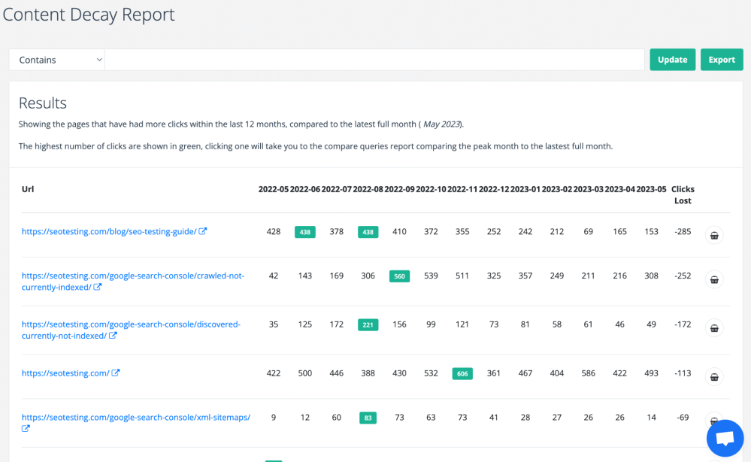
Looking at this, I can see that our guide on SEO testing has lost nearly 300 clicks over the last 13 months. This is a surefire sign that the content could do with a refresh.
Next, I'll look at the Questions to Answer report:
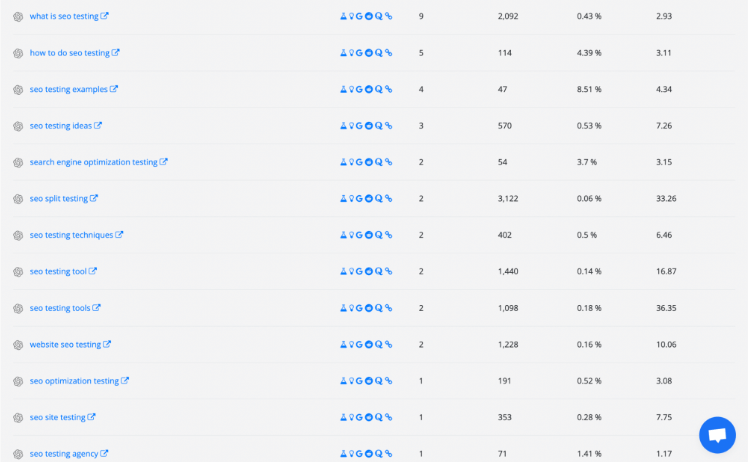
From this, I can see some good examples of questions like how to do SEO testing and SEO testing examples that we already rank for, but could do with a little push to ensure we get more clicks. This gives me some good ideas as to what I can add into the content (or topic cluster if I go that route).
I can do a similar thing with the Striking Distance Keywords report:
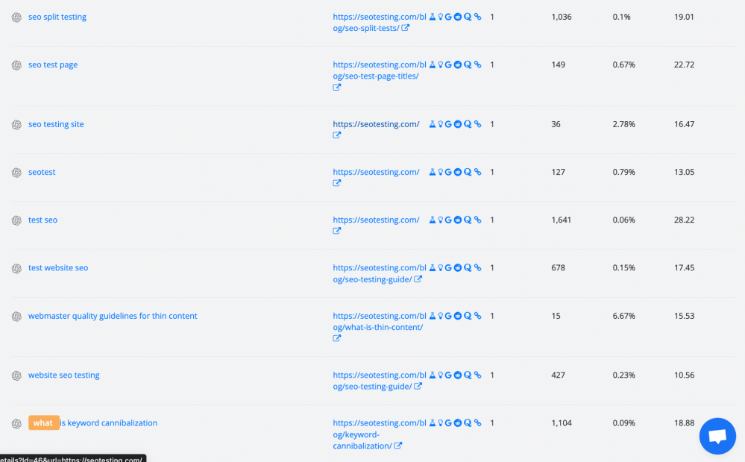
Here, I can see some good keywords where our guide ranks just off page one. Potentially adding these keywords into the content more, or doing some more targeted internal linking will help boost the page for these keywords. This will help me when planning out my content refresh.
Conducting a content gap analysis is helpful too:
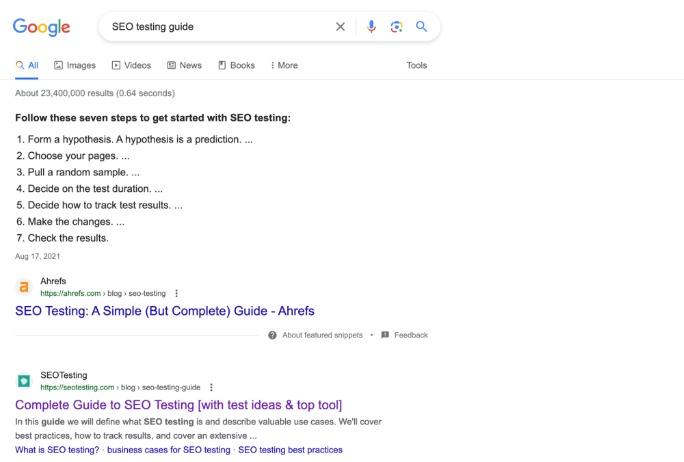
Here, I can see that Ahrefs currently ranks above us for the keyword "SEO Testing Guide". I can take a look at their content and see what their piece of content has that ours does not and get this added into our content to ensure we are properly matching search intent. This will give us a better chance at getting ahead of their piece in the SERPs.
Using the tools and methods above, I can properly flesh out a content refresh that will give our piece the best chance at becoming more successful in the SERPs.
Once I have been through and updated the content, ensured it has been re-crawled and re-indexed by Google, I'll then go through and set-up a test within SEOTesting to see how the refreshed content performs in terms of:
- Clicks per day.
- Impressions per day.
- Average page position.
- Click through rate.
SEOTesting will then monitor the data over a period of time (we recommend 6-8 weeks for an SEO test, but a minimum of 2 weeks is recommended) and we end up with a report that looks like this:
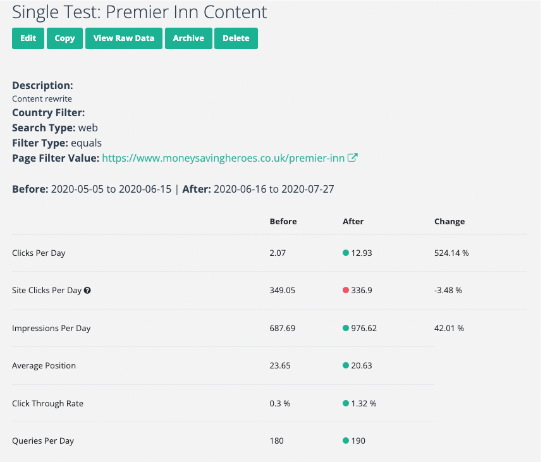
We can see from the test above, we completed a content re-write and had great results!
We are also able to see the change in clicks, impressions and queries in a graph which looks like this:
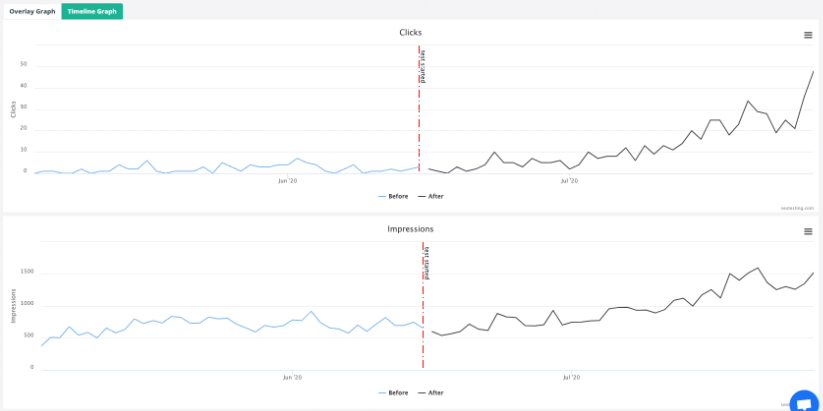
This is what we'd describe as a very successful content refresh. We increased clicks per day by over 500%, impressions per day by over 40% and our click through rate rocketed from 0.3% to 1.32%!
Content Quality Review Workflow
Content work in SEO doesn't (generally) start with writing new content or optimising existing pieces, it will start more often than not with a review of all the content that is currently on the site, including those that are low-quality.
Finding the pieces of content that Google considers low-quality is crucial. It will allow us to put them in the queue for a content refresh, or delete from the site entirely.
A content quality review workflow might look something like this:
- Identifying low-quality content.
- Organising the content that can be refreshed and the content that can be deleted.
- Adding content refreshes into the content calendar.
- Completing content refreshes.
- This will now link to the content refresh workflow we've written more about above, which further shows how you can use different workflows together to achieve content success.
Here's an example of what I'd do for the SEOTesting website:
I'd start by looking at the Low-Quality Content Report. Here, SEOTesting will find all of the pages Google considers low in quality and list it out for me so it is easy to read and understand:
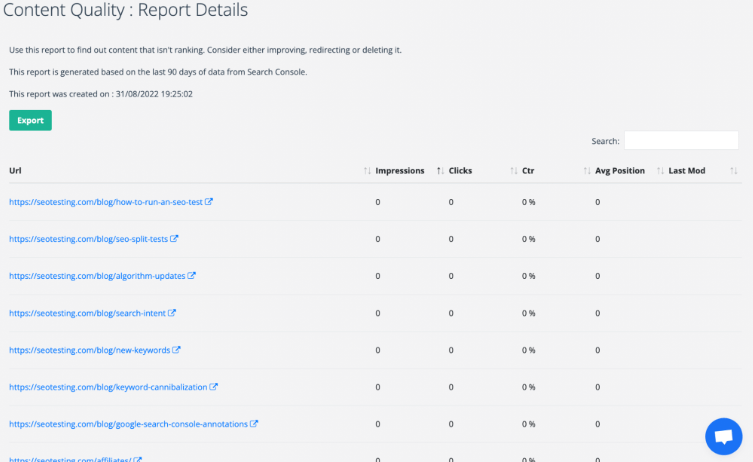
From this, I can see the following pieces of content have not generated any impressions or clicks in the last 90 days:
- How to Run an SEO Test
- SEO Split Tests
- Algorithm Updates
- Search Intent Report
- New Keywords Report
- Keyword Cannibalization Report
- Google Search Console Annotations
I'll now need to go through all of these pieces of content and identify whether these need to stay on the site (and may just need a refresh) or whether they can be deleted from the site or merged with another piece on the same topic.
Using the "How to Run an SEO Test" piece as an example. I can do a little investigative work to establish whether this piece can be deleted or refreshed.
I have searched the target keyword "how to run an SEO test" through the Nightwatch SERP Simulator, and found our page ranks incredibly highly in the US for this keyword:
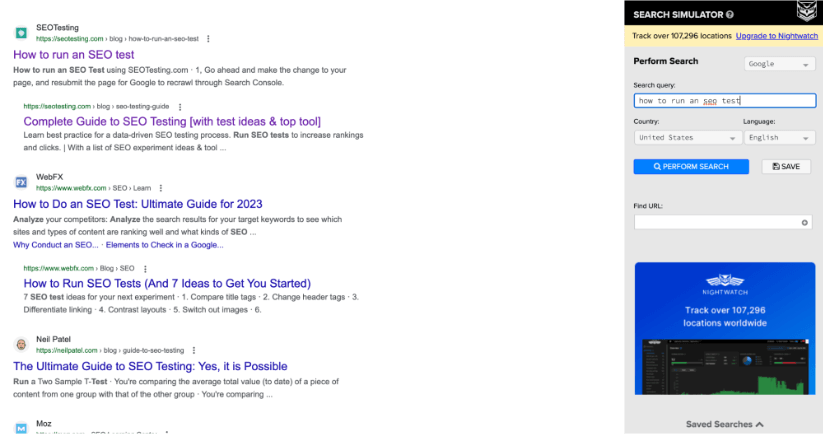
It actually ranks at Position 2.
This tells me, given that the page has had no impressions or clicks in the last 90 days, that there isn't actually search volume for this keyword. In addition, competing content is more focussed around general guides on SEO testing.
Because of this, I think it is going to be worth redirecting this URL to our main guide on SEO testing, and ensuring our main guide also covers how to run an SEO test. This will be the course of action moving forward.
CTR (Click Through Rate) Optimisation Workflow
Another big part of content-based SEO is CTR optimisation, or the process of optimising meta titles, descriptions, page titles and content to improve click through rates from the SERPs to the website.
When you think about a workflow for CTR optimisation, it could look something like this:
- Identify pages with a low CTR.
- Look for missing queries with search volume that could be used to improve CTR.
- You can use the SEOTesting Top Query Per Page Report to help here.
- Compare the meta titles, meta descriptions and page titles with competitor content.
- Re-write these meta tags.
- Publish the changes.
- Run a test to evaluate whether the test has been successful or not.
Here's what this workflow could look like in practise.
My first point of order will be to look at the SEOTesting Top Query Per Page report:
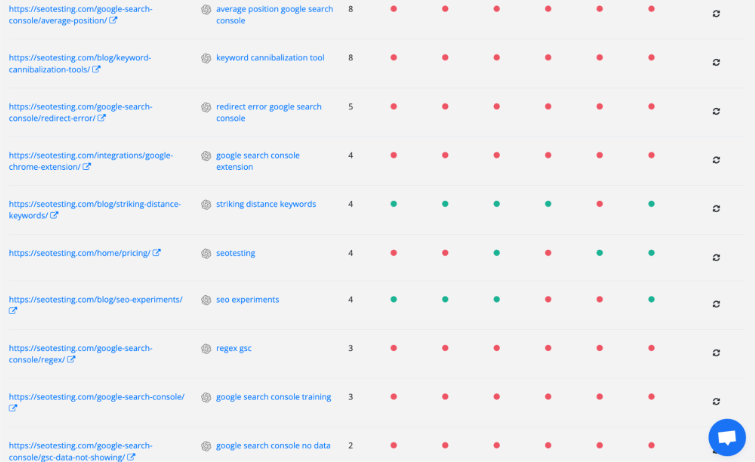
There are some good examples here. I can see that our piece of content on Google Search Console's Average Position metric ranks well for the "Average Position Google Search Console" query, but yet this is not included in the page title, meta description, H1, H2 or H3 within the content.
This is a good idea for a bit of CTR optimisation.
I'll go into the page on the back-end, and update some of the content so it includes this query.
I'll then set-up a test within SEOTesting:
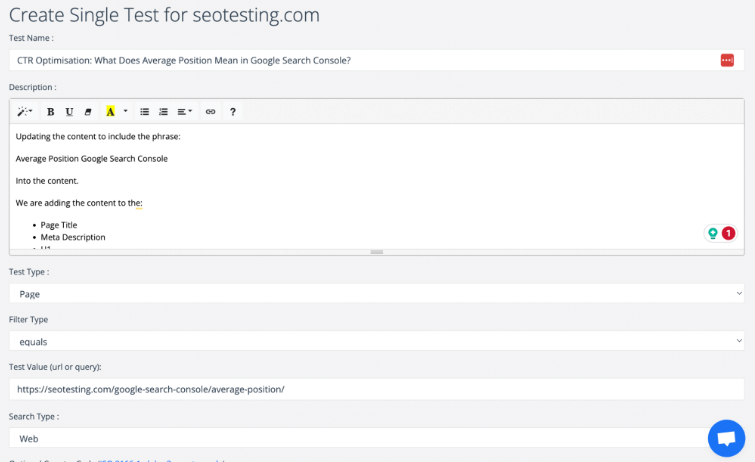
Once the page has been updated and the test has been set-up, I can wait and monitor the test to see if it is successful in increasing the page's CTR. If it does, I can also expect to see an increase in the page's clicks.
Content Strategy Workflows
Of course, it is worth mentioning that SEO workflows do not need to be siloed for one-off tasks like creating or optimising content. You can also have an SEO workflow which determines you entire content strategy.
Within this workflow, you'd have information on the research stage such as what content is being researched, who is in-charge of this process and what the outcome should be.
You'd then have information listing your content distribution strategy. How many pieces of new content are you going to publish per week/month? How many pieces of content are you going to update per week/month? Who is going to be responsible for the content-side of your SEO strategy? A targeted SEO workflow will help you answer all of these questions.
Tools to help you manage your SEO workflows.

This is a difficult topic / question to explore in a short section of a larger blog posts as it warrants a new blog post of its own. We will come to this one day in the near future, but in the meantime, there are some tools that you will need, regardless of what your SEO workflow looks like currently or will look like in the future.
The first thing you are going to need is a project management tool such as Monday, Asana or Notion. This will allow you to define the steps within your workflow, assign tasks to different people within your organisation and keep track of ongoing projects. As an example, SEOTesting use Notion, but your organisation might find a program better suited to your needs.
You then need access to a suite of SEO tools, with the main two on the market being Ahrefs and Semrush. This is going to allow you to keep track of your organic ranking, page positions, new backlinks that have been built and allow you to do content research. These tools are then paired with Google Analytics (hopefully now GA4) and Google Search Console.
You also need to ensure you have tools in place to work collaboratively on content projects (and other SEO projects). We use Google's suite of tools for this as it makes it incredibly easy to work on documents together, make changes to someone else's work etc. You can also use Microsoft Office paired with a document management tool like Dropbox.
Hopefully this has given you a good insight into SEO workflows for content success, and how they can be used within different business types.
If you are interested in seeing if SEOTesting can help improve your SEO workflow, give us a try! We have a 14-day free trial with no credit card requirement.

